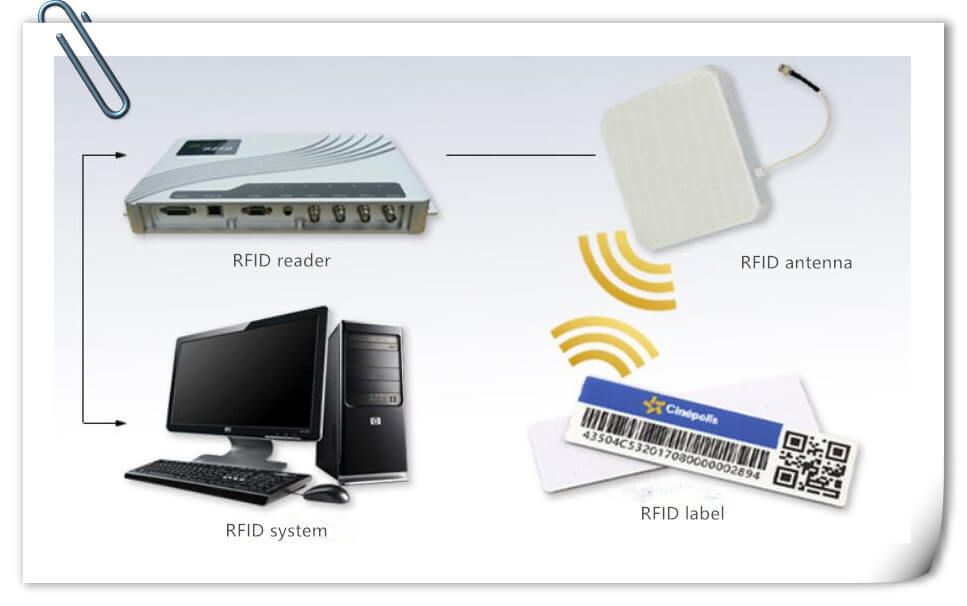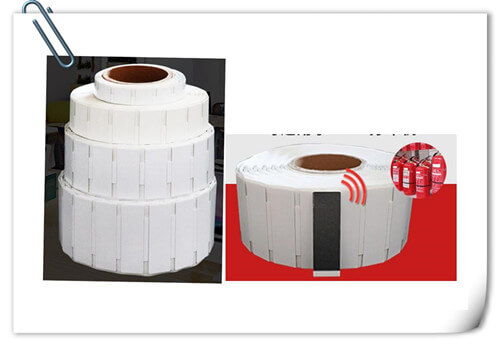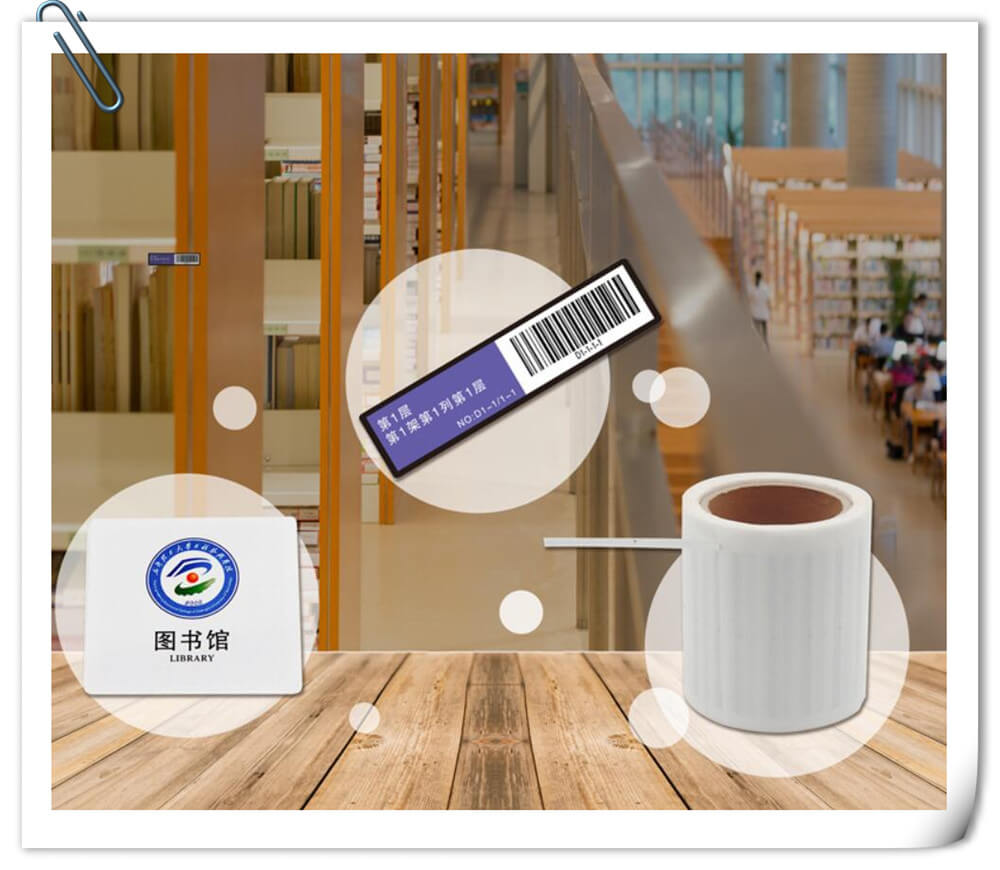RFID labels
D.O RFID Tag manufacturer produce RFID Library Credentials are labels (or tags) that are widely used for automatic data capture in library applications(i.e., academic, public, corporate, and other special applications). RFID technology provides an enhanced user experience for library applications and in related industries that require item tracking. The maximal read/write distance between I-CODE SLI smart card and reader is 1.5m, but the actual distance depends on the field power generated by the reader and its antenna size. wireless read/write capability.Features
- Compatible: Full compatibility with existing infrastructures
- Global solution: Usable by major libraries worldwide
- Tested: Quality label with 100% testing
- Customizable
What are the RFID Labels
RFID(Radio-Frequency Identification)labels are RFID stickers or RFID adhesive labels. they are powerful devices used by medical facilities, research study facilities, and also IVF laboratories for record-keeping, accessibility control, stock monitoring, person, and also example management, and far more.
RFID label has at least 3 components: an integrated circuit for refining and also keeping information that regulates as well as demodulates radio-frequency (RF) signals; a means of gathering DC power from the reader signal in the vicinity; and also an antenna for transferring the signal as well as obtaining. The tag info is kept in non-volatile memory and also can include either dealt with or programmable reasoning for processing the transmission and sensing unit data, respectively.
RFID label might either be read-only, having a factory-assigned serial number that is used as a key right into a database, or possibly read/write, where object-specific data can be written into the tag by a system user. Field programmable tags may be write-once, read-multiple; "empty" tags might be written with an electronic printer encoder. Numerous businesses are opting to make use of clever labels with printed barcodes as well as human-readable details that include the embedded RFID wiring. Making use of a clever tag in an RFID installment optimizes the most recent monitoring of modern technology in the marketplace.
How RFID labels work
We have developed an RFID label inlay specialty and have supplied several thousand customized RFID labels to some of the largest brands in the world. Our team of experts will be here to help you get the right RFID inlay for the label and the ideal label for your product.  Inventory surveying and handling for other RFID applications, RFID labels also known as smart labels are a valuable way of labeling and assets monitoring.
Inventory surveying and handling for other RFID applications, RFID labels also known as smart labels are a valuable way of labeling and assets monitoring.
RFID labels, also called smart labels, are a useful tool for tagging and asset tracking, monitoring inventories, and handling other RFID applications.
RFID is radio frequency identification. RFID technologies use radio waves to collect and send information, but they need not have the visibility between a label and a scan unit, similar to the way that bar codes collect and send data with a visual scan, but it doesn’t require a line of sight between a label and a scanning device.
It is their ability to submit information to a networked system that makes RFID tags unique. You can use your computer system in conjunction with RFIDs to find your items, log your stock automatically, and obtain actionable logistics data rather than having to search each item individually using UPC codes and barcode scanners. It is a very powerful way to handle inventories and now opens the door to new mobile payment systems.
The RFID technology enables wireless and bidirectional communication between a smart RFID label or tag and an RFID reader. The "transponder" typically made of polyester film with a printed or etched antenna embedded in a silicon chip is at the heart of the technology. You have an RFID tag. Apply a printed or printed facial stock on top. Apply a printed or printable face-stock to the top and you have an RFID tag. Add an adhesive to the bottom and you have an RFID label. These "smart" tags and labels can then addressed by an RFID reader, also called an "interrogator".
The RFID label includes at least three components: integrated information storage and processing circuit to modulate and demodulate RFs, the means of collecting power from nearby readers, and the signal antenna to receive and transmit. The tag information is saved in non-volatile memory and can contain either fixed logic and programmable data processing logic.
RFID label tags may either be read-only, having a factory-assigned serial number that is used as a key into a database, or maybe read/write, where object-specific data can be written into the tag by a system user. Field programmable tags may be write-once, read-multiple; “blank” tags may be written with an electronic printer encoder. Many companies are opting to utilize smart labels with printed barcodes and human-readable information which include the embedded RFID circuitry. Utilizing a smart label in an RFID installation optimizes the latest tracking technology in the marketplace.
RFID label benefits
It is their ability to submit information to a networked system that makes RFID tags unique. You can use your computer system in conjunction with RFIDs to find your items, log your stock automatically, and obtain actionable logistics data rather than having to search each item individually using UPC codes and barcode scanners. It is a very powerful way to handle inventories and now opens the door to new mobile payment systems.
Wide Range Scanning
RFID smart labels can be simultaneously scanned and displayed in batches from a few inches to a few feet, with no full view / sight-line. This compares with 1D and 2D barcodes, which need maximum visibility and is scanned with high image quality. Thus, even when it's covered or integrated into a bottle, RFID tag labels are able to transmit their signal within a wide range of readings and scan into a 360° range. This allows greater freedom for RFID labeling in tag positioning, which decreases the chance of the label falling down or being removed.
Flexible UHF labels

The UHF labels have a passive UHF-inlay which doesn't need a battery to run. They are powered by a signal issued via the internal antenna of the RFID scanner/ reader in a specific back-reflected pattern. This design allows for much smaller RFID label designs while the flexibility of the inlay allows labels to be applied to different surfaces, including curved surfaces. However, passive RFID labels require a data processing system to store and process data scanned.
Printed & Encoded
The RFID label can encrypt much more information than barcodes and the RFID technology provides encryption and physical protection for your data. Furthermore, RFID thermal labels can be printed with serialized text and barcodes with most thermal transfer printers. This allows you to print general information that can be read visually while maintaining the confidentiality of sensitive data.
This combination of RFID and bar codes allow RFID tag labels to be completely incorporated into the laboratory management system, accelerating routine processes such as sampling, inventorying, and tracking. All in all, RFID supports and saves time on sample workflows.How to purchase RFID labels?
DO RFID TAG supplier is the leading RFID label manufacturer and help you how to choose RFID labels.
There are several factors to consider when selecting RFID labels, but these three are the most important:
1. RFID Inlay Size. A larger RFID inlay gives you longer read ranges.

2. RFID Reader Types. Handheld RFID readers, fixed RFID readers and overhead RFID readers often perform differently and serve different use cases.
3. Material Surface and Environment. The surface of the material, such as corrugate box, wood, glass, plastic, metal, etc., as well as how densely items are stacked, or what is contained within the boxes.
If the signal must pass through objects that attenuate the signal, the read range is diminished.
4. RFID Label application
Your application will enable us to recommend the material and adhesive you need, and the type of label and tag that could withstand exposure to extreme cold, heat, moisture, UV light, etc.
5. Selection of the right RFID chip
We can decide whether a regular or high memory label works better, and your application needs privacy protection or encryption level.
Low Frequency (LF) 125Khz RFID label
Low Frequency (LF 125khz) labels are the longest wavelength and are suitable for the demanding fluid RF and metal material environments that are common for animal identification and smart key applications. Reading ranges (centimeters to half meters) typically are small and tag programming is often programmed to a single, stable identifier.
High Frequency (HF 13.56mhz RFID label ) and Near Field Communication (NFC label)
High frequency (HF 13.56mhz RFID) and Near Field Communications (NFC) labels or stickers both operate in the same frequency and have a shorter read range (centimeters to a meter). The RFID label HF 13,56mhz is commonly used for healthcare, intelligent label monitoring or ticketing applications, and library applications where close reading is required and ideal RF environments cannot be tested. The majority of smartphones have an NFC reader or scanner and applications in which a tap on the tag will take the user to web pages, social media, or other NFC marketing applications. The maximal read/write distance between I-CODE SLI smart card and reader is 1.5m, but the actual distance depends on the field power generated by the reader and its antenna size.
Ultra-High Frequency (UHF)
Ultra-high frequency UHF labels or stickers are ideal for long-range read-to-write applications (one to 20 meters). UHF applications are ideal for item-level visibility where dense tag populations and movement are in play typical of manufacturing, healthcare, RTLS, asset tagging, and tracking projects.
Dual Frequency (UHF and NFC)
Dual Frequency Tags or labels or stickers combine the long-range read/write ability of UHF RFID with the user-level functionality of NFC tags and labels. The result is a multi-function tag that provides the visibility for manufacturing, inventory, and logistics applications and the brand interaction goals of NFC marketing into a single tag with a shared chip that can be read or programmed with a smartphone.
Custom RFID stickers or RFID labels
Our advanced machine and RFID manufacturing devices allow us to fulfill the specific requirements of your RFID application:

Each size and settings of labels
Hundreds of pre-test materials from which to choose
Pre-printed with color flood coats, graphics, and logos
All big RFID inlay brands, such as Zebra, Alien, Avery Dennison, Smartrac, BoingTech, Tageos, Stora Enso All big IC tags like NXP, Impinj, Alien, EM Micro
DO RFID Tag Supplier produced a wide range of solutions to ensure readability on metal, water, plastic, and challenging surfaces.
Flag Designs RFID labels: Distances the RFID inlay from the metal surface or works with the metal asset to provide reliable readability.
Special RFID Labels: Spacer between RFID labels, slotted ground plane, permanent adhesive, durable face stock. They are thin, flexible, printable on-demand, and work directly on metal.
Encapsulated RFID Tags: Inlay inserted between two tag materials for applications where the adhesive is not needed.
We also offer complete customization options to meet specific applications, in addition to the available RFID options, which can be printed with serialized bar codes and coded with alphanumerical values. This includes the selection of one of our durable label faces to produce an RFID label capable of resisting chemical exposure and a variety of temperatures. We offer highly efficient specialty labels to deliver unique and reliable ID and tracking solutions from RFID inlay, antennas, and label size combinations to configuration and material selections.RFID label cost
DO RFID TAG Manufacturer Provide a comprehensive selection of In-Stock RFID Labels that finished testing by RFID and RFID printers from Zebra.
These RFID labels are designed for use with RFID readers and are stocked in a variety of RFID inlay types and sizes. They are available on non-metallic surfaces, plastics and corrugates in paper and PET products.
The high-sensitivity UHF label with a readability of up to 17 meters in free space ensures clear, reliable efficiency and a better ROI.
These advanced RFID labels provide greater readability than our general RFID labels for use with longer ranges and inlays from leading providers. Provides efficient performance with omnidirectional readability from almost any angle when positioned or close to difficult materials.
RFID Labels with Standard 128-bit memory inlay with a read range of up to 20m, or with Enhanced 448-bit EPC and 1024-bit user memory inlay with a read range of up to 12m.
The special rfid label cost is more expensive than common RFID labels, the price range from USD0.1-USD1.0. Contact us to get an RFID sticker price list.
RFID label applications

For years, RFID label producers have used RFID labels to track products through every step of the shipping, delivery, and purchasing process. Today, RFID labels are becoming a standard part of the retail chain and are also being used in security applications, baggage tracking, pharmaceuticals, retail medical devices, and healthcare products.
In the healthcare sector, the main advantage of RFID labels is the avoidance of misidentification. RFID tags allow patient specimens to be monitored in real-time, from collection to trial, ideal for clinical and testing facilities. You can also effectively control the supply chain, increase the accuracy of the inventory, can be programmed to send medical alerts to staff, and use it for finding useful samples. Thermal RFID labels make it easier to track and control workflows in laboratories, which are good for use in histologies, pathologies, and clinical laboratories.
RFID labels are being used to track their products and sales by big retail stores such as Wal-Mart, Sam's Club, Best Buy, and other businesses. In the process of label printing, RFID technology will become even more standard as more customers shop with mobile apps, such as Google Wallet and Apple Pay.
Cannabis, CBD, and hemp goods seed-to-sale traceability
In cannabis supply chains, RFID label monitoring is required – allowing for greater visibility of inventory, supply, and origin, both by regulators and brands.
Some brands are also leveraging near-field communication (NFC) labels, a type of RFID technology so that they can also communicate key educational and product-use information with their consumers. The majority of smartphones have an NFC reader that enables customers to search a label for unique product details such as ingredients, origin, laboratory test results, and many more.
T&L
Distribution, shipping and receiving, warehouse operations including the case, pallet and cross-docking applicationsManufacturing
Work-in-process, product labeling, product ID/serial numbers, security, and product lifecycle tagging Fleet management; metal and liquid-filled containers Asset tracking of tools, fixtures, metal parts, returnable containers, chemical drums and moreHealthcare
Patient ID, specimen, laboratory and pharmacy labeling, document and patient records management Asset tracking of wheelchairs, beds, oxygen canisters, IV pumps and medical diagnostic toolsRetail
Asset tracking of mobile computers, printers, antennas and infrastructure componentsRFID labels manufacturers
We embed RFID IC into die-cut labels for our customers, produce in both prime RFID label and unprinted thermal label formats, so we can put RFIDs in any product label.
In order to ensure the highest level of quality and consistency between products meet ISO 9001-2000 process standards
We develop personalized RFID inlays to make your RFID application maximum successful - your RFIDs work with your mark.
Provide a commodity 100% checked to meet the strict demands of government local, national, federal, and international regulations
Our expertise in meeting all retail requirements is a licensed vendor with leading retailers such as Wal-Marten, Lowe's, Target, Safeway, and others. We help you through the complexities of RFID orders, help you improve your inventory, and deliver RFID labels (or any other pressure-sensitive labels) that fit your products. All while providing an excellent customer experience.
Consistently Outstanding QualitySpecification
| RFID Labels | ||
|---|---|---|
| material | Base material | PET; 3M glue |
| Antenna material | Aluminum etched antenna ; | |
| Chip material | original chips | |
| Protocol | ISO 14443A | |
| Frequency | 13.56MHz (HF) | |
| Chips | NTAG 215 | |
| Reading Distance | 0.1~10m(depend on reader, tag and working environment ) | |
| Working mode | read-only or read-write according to chip type | |
| Read/write endurance | >100,000 times | |
| customized serivice | 1. custom printing logo, text | |
| 2. pre-code: URL, text , numbers | ||
| 3. size, shape | ||
| Packing | 5000pcs/roll ,1-4roll/carton,or by customized | |
| Working temperature | -25℃to+85℃ | |
| D.O RFID TAG Manufacturer | Professional NFC proucts Factory here now. OEM and ODM One-stop service Customized, happy send sample to you confirm quality. | |






